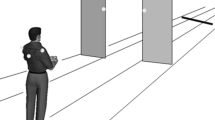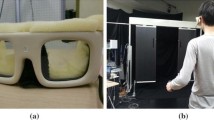Abstract
Eight healthy subjects were asked to walk blindfolded along circular paths of different radii after several practice trials with vision. Their task was to stop after completing two full revolutions. They always walked counter-clockwise (CCW) in (a) a control condition (CONTROL), including the instructions mentioned above, (b) with the further instruction to count backwards in twos (MENTAL), (c) with the instruction to count loudly (LOUD). The movement of two markers lying along the head naso-occipital axis was recorded by means of an ELITE system. Total walked distance (DISTANCE), total head turning angle (ANGLE) and average radius (RADIUS) of the trajectories performed were measured. All subjects were able to perform approximately circular trajectories. They consistently overshot the ideal radius independently of the condition and circle size, undershot the total angle and overshot total distance. The LOUD condition induced greater errors in the performance but only on total distance (P<0.05). A strong correlation was found between the errors in radius and total distance but not between distance and total angle. Principal components analysis suggested that radius and distance share a common source of errors while total angle produced independent errors. The results indicate that (a) circular trajectories can be generated starting from spatial and/or motor memory, without the aid of visual information; (b) the task needs some attentional control and does not involve simple automatic processing of afferent information; (c) different sensory information or different processing modes are probably involved in the estimation of the curvature and length of the walked path on the one hand, and of the total rotation angle on the other.
Similar content being viewed by others
Author information
Authors and Affiliations
Additional information
Received: 1 June 1996 / Accepted: 18 January 1997
Rights and permissions
About this article
Cite this article
Takei, Y., Grasso, R., Amorim, MA. et al. Circular trajectory formation during blind locomotion: a test for path integration and motor memory. Exp Brain Res 115, 361–368 (1997). https://doi.org/10.1007/PL00005705
Issue Date:
DOI: https://doi.org/10.1007/PL00005705




